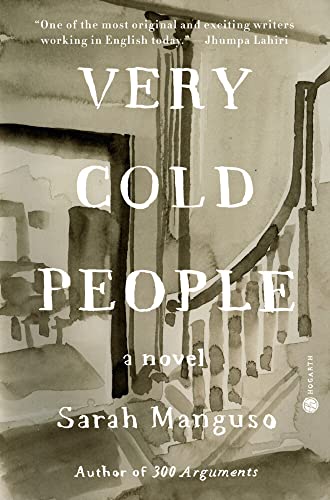Sarah Manguso’s books reflect an ongoing processing of thoughts, themes, and experiences. Ongoingness, published in 2015 and composed of aphoristic short paragraphs (many just a sentence long), describes her habit of keeping diaries. Most of her works, she says, don’t look like books until she’s nearly done with them.


Manguso began with poetry (2002’s The Captain Lands in Paradise, 2006’s Siste Viator), then collaborated with Dave Eggers and Deb Olin Unferth on a volume of short stories, 2007’s One Hundred and Forty Five Stories in a Small Box. Her work earned her the Rome Prize that year, and in 2008 she published The Two Kinds of Decay, a well-received memoir about dealing with a rare autoimmune sickness, which established her fragmented prose style.
With 2012’s The Guardians, a fractured work of nonfiction, she explored the circumstances around her friend’s suicide. After that, she received support from a Guggenheim fellowship and continued teaching at various universities, having worked as an adjunct at Columbia, among other schools.
Manguso, 47, is seated in her kitchen in Los Angeles, where she moved several years ago from Brooklyn. She is wearing her hair straight in a medium bob with rectangular framed glasses. A gray tabby cat is underfoot, and she’s surrounded by a series of original Jenny Holzer prints from the artist’s Truisms series.
She acquired the prints in the late 1990s, when she was living in a small apartment in Brooklyn, where they took up all the wall space. Now, in her bright, airy house, they’ve got more room to breathe. “They’ve just been around me ever since,” she says. “I think of them as this mantle of language that keeps me well and safe.”
The Truisms are just there in the background, Manguso explains; she doesn’t think about what they say. It may not be the content that’s important, but the pithy form of Holzer’s messages—which consist of all-caps black text on white backgrounds and which were ubiquitous on New York City streets in the 1970s and ’80s—provides an obvious clue to the formation of Manguso’s style. Holzer: “Decadence Can Be An End In Itself.” Manguso, from 2018’s micro-essay collection 300 Arguments: “Sometimes ill-informed choices have good outcomes.”
Manguso’s latest, Very Cold People (Hogarth, Feb. 2022), follows a girl named Ruth as she comes of age in 1980s Massachusetts, in a town built in the colonial era. The project didn’t start as fiction. For decades, she had wanted to write her “Boston book,” she says, about the whiteness, class differences, and intergenerational trauma that were prevalent in the 400-year-old town she grew up in outside of Boston.
She imagined the book would be nonfiction, but, she says, “it turned out that memoir wasn’t a large enough form to contain everything.” Ruth is not Manguso, and though Ruth is deeply perceptive about her family members, friends, and neighbors, there’s no indication that she will become a writer. Rather than tell her own story, Manguso uses Ruth to convey a painful series of stories about how she, her family, and her friends are impacted by the town in various ways.
“So,” Manguso says, “despite the fact that I’ve spent my entire career saying I would never write a novel, that I had no interest in writing a novel, I realized this was the form I needed.”
PJ Mark, Manguso’s agent at Janklow & Nesbit, says his client “had already mastered precision in her nonfiction,” so, in a way, “fiction seemed inevitable.” Mark thinks the form gives her “a freedom to explore characters and plot with ferocity.”
Manguso left Massachusetts in her early 20s, and it took just as many years of being away for her to write Very Cold People. Though she spent over a decade in Brooklyn, she credits her contrasting new surroundings in Southern California with giving her the perspective she needed.
She calls her hometown an “active palimpsest—a lot messier and more scribbly and complex than L.A.,” noting that people in the Northeast are much more class conscious than those in California. In Massachusetts in particular, Manguso says, class seems a more present force. Social classes that had been determined in the 17th century remained at the forefront of peoples’ minds in the 1980s, when she was growing up. “That was something really important that I wanted to write about,” she says.
The societal forces operating in Very Cold People’s fictional town of Waitsfield are determined by heritage, with founding families whose members trace their roots to the Mayflower voyage at the top of the pecking order, even if they don’t have any money. Living in houses that have passed through their families for hundreds of years, they enjoy a status that can’t be bought, which keeps Ruth and her Italian father and Jewish mother feeling hopelessly lesser than.
When Ruth is a young girl, her mother develops a habit of clipping photos of strangers in the newspaper’s wedding notices and sticking them on the fridge. Her anxiety about class status prompts her to look down on some relatives and ingratiate herself with others. When Ruth is a teenager, her family moves into a new house in a tonier part of town where a woman from the colonial Cabot family once lived. However, because the house was built in the early 20th century, Ruth’s parents don’t achieve the social status the move presumably should have brought.
Meanwhile, Ruth waits until she’s old enough to get out. The name of the town, Waitsfield, is a clear metaphor for the condition she’s frequently subjected to. “A kid in the ’80s would have the skill of being able to wait with nothing to do, nothing to read, no friend to text,” Manguso says, remembering her own experience as a Gen-X kid. As a writer in the age of screens, she developed an “opposite skill, which is to keep the information away.”
Among the subjects of Ruth’s interest is the pervasive instances of sexual assault that surround her. One friend’s bedroom is frequented by the girl’s father. Another friend’s brother tickles her after her showers until her towel falls off. Another friend sleeps with a tennis coach. After Ruth’s gym teacher gropes her, she reflects, “I understood that it was wrong, but, after my first thought, which was that maybe this is normal, I found it sweet. I knew that, on some level, he liked me.”
By the end of the narrative, serious mental health episodes and tragic circumstances befall most of the girls. “Everything is based on the fact that all the girls in Waitsfield are going to be touched, molested, raped, abused, neglected, and just, you know, in many cases destroyed,” Manguso says.
The style of Very Cold People is subtle, marked by the accrual of short essayistic paragraphs separated by empty lines. The dark material is alternately conveyed with understatement and frank facts, but there’s always a sense that Manguso gives great care to Ruth, and to the reader, by bringing clarity and honesty to her protagonist’s observations. It’s bold and distinctive, like her past work, which hasn’t always been appreciated by gatekeepers. (When Ongoingness was out for submission, one editor suggested she forego publishers and, instead, publish it on a mom blog.)
Manguso says she’s lucky to have people on her side who help turn her work into a “marketable product.”
Mark notes that Manguso’s writing “commands—demands—attention.” He thinks she “always knows exactly the kind of book she wants to construct and why, and what she wants to say.”
Manguso says her success has freed her from “having to do a lot of other jobs,” aside from her current job teaching at Antioch University Los Angeles. Her smile widens and a line from Holzer can be glimpsed in the frame behind her head: “You don’t know what’s what until you support yourself.”
This piece was produced in partnership with Publishers Weekly.












